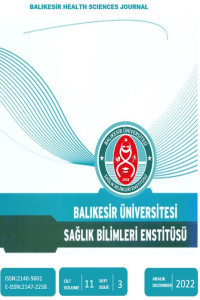Akut Pankreatitli Hastalarda Yaş Şok İndeksinin Kritik Hasta Ayrımındaki Etkinliği
Şok indeksi, Yaş şok indeksi, Modifiye şok indeksi, Akut pankreatit, Triyaj
The Effectiveness of the Age Shock Index in Critical Patient Discrimination in Patients with Acute Pancreatitis
Shock index, Age shock index, Modified shock index, Acute pancreatitis, Triage,
___
- Referans 1. Neoptolemos JP, Raraty M, Finch M, Sutton R. Acute pancreatitis: the substantial human and financial costs. Gut. 1998;42:886–91.
- Referans 2. Mann DV, Hershman MJ, Hittinger R, Glazer G. Multicentre audit of death from acute pancreatitis. Br J Surg. 1994;81:890–3.
- Referans 3. Appelros S, Lindgren S, Borgström A. Short and long term outcome of severe acute pancreatitis. Eur J Surg. 2001;167:281–6.
- Referans 4. Banks PA, Bollen TL, Dervenis C, Gooszen HG, Johnson CD, Sarr MG, et al. Classification of acute pancreatitis 2012: revision of the Atlanta classification and definitions by international consensus. Gut. 2013;62:102–11.
- Referans 5. Janisch NH, Gardner TB. Advances in Management of Acute Pancreatitis. Gastroenterol Clin North Am. 2016 Mar;45(1):1-8.
- Referans 6. Rassameehiran S, Teerakanok J, Suchartlikitwong S, Nugent K. Utility of the Shock Index for Risk Stratification in Patients with Acute Upper Gastrointestinal Bleeding. South Med J. 2017 Nov;110(11):738-743.
- Referans 7. Otero R, Nguyen B. Şoktaki hastaya yaklaşım. Judith Tintinalli, et al. [çev.] Cem Ertan. Acil tıp Kapsamlı Bir Çalışma klavuzu. İstanbul : Nobel Tıp Kitapevi, 2013;65-172.
- Referans 8. Sankaran P, Kamath AV, Tariq SM, Ruffell H, Smith AC, Prentice P, et al. Are shock index and adjusted shock index useful in predicting mortality and length of stay in community-acquired pneumonia? Eur J Intern Med. 2011 Jun;22(3):282-5.
- Referans 9. Mutschler M, Nienaber U, Münzberg M, Wölfl C, Schoechl H, Paffrath T, et al. The Shock Index revisited - a fast guide to transfusion requirement? A retrospective analysis on 21,853 patients derived from the TraumaRegister DGU. Crit Care. 2013 Aug 12;17(4):R172. doi: 10.1186/cc12851.
- Referans 10. Torabi M, Moeinaddini S, Mirafzal A, Rastegari A, Sadeghkhani N. Shock index, modified shock index, and age shock index for prediction of mortality in Emergency Severity Index level 3. Am J Emerg Med. 2016 Nov;34(11):2079-2083.
- Referans 11. Yu T, Tian C, Song J, He D, Sun Z, Sun Z. Age Shock Index is Superior to Shock Index and Modified Shock Index for Predicting Long-Term Prognosis in Acute Myocardial Infarction. Shock. 2017 Nov;48(5):545-550.
- Referans 12. Phillip V, Steiner JM, Algul H. Early phase of acute pancreatitis: assessment and management. World J Gastrointest Pathophysiol. 2014 ve 5:158–168.
- Referans 13. Whitcomb DC. Clinical practice. Acute pancreatitis. N Engl J Med. 2006 May 18;354(20):2142-50. doi: 10.1056/NEJMcp054958.
- Referans 14. Kim SY, Hong KJ, Shin SD, Ro YS, Ahn KO, Kim YJ, et al. Validation of the Shock Index, Modified Shock Index, and Age Shock Index for Predicting Mortality of Geriatric Trauma Patients in Emergency Departments. J Korean Med Sci. 2016 Dec ve 31(12):2026-20.
- ISSN: 2146-9601
- Yayın Aralığı: Yılda 3 Sayı
- Başlangıç: 2012
- Yayıncı: Balıkesir Üniversitesi
Hemşirelik Öğrencileri İle Bir Metafor Analizi: Onkoloji Hemşiresi Olmak
Hastane Çalışanlarında Üstünlük Vehmi-İş Tatmini İlişkisi
COVID-19 Enfeksiyonu ve D Vitamini Düzeyleri Arasındaki İlişki
SARS‐CoV‐2’nin Erkek Üreme Sistemi Üzerindeki Etkileri
Emine SARMAN, Kanat GÜLLE, Abdullah SARMAN
Down Sendromu Tanılı Olgularda Aile ve Çocuğa Ait Sosyodemografik Özelliklerin Değerlendirilmesi
Zülfünaz ÖZER, Gülcan BAHÇECİOĞLU TURAN, Damla ÖZTÜRK
Sağlık Okuryazarlığının Yaşam Kalitesine Etkisinde Özbakım Gücünün Aracı Rolü
Mahmut AKBOLAT, Mustafa AMARAT, Pelinsu Buket DOĞANYİĞİT
Akut Pankreatitli Hastalarda Yaş Şok İndeksinin Kritik Hasta Ayrımındaki Etkinliği
Hemşirelik Öğrenci Deneyimlerini Dijital Hikaye İle Anlama
Aydanur AYDIN, Zeynep TATLI, Ayla GÜRSOY
COVID-19 Salgınının Diş Hekimleri Arasında Yarattığı Korku ve Kaygının Değerlendirilmesi
